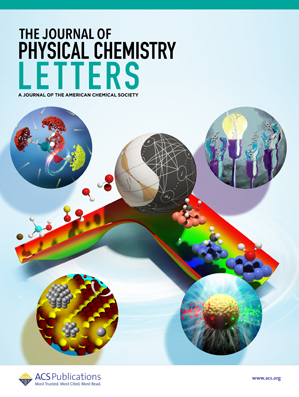钝化配体对Au25(SR)18自旋极化发射的影响。
IF 4.8
2区 化学
Q2 CHEMISTRY, PHYSICAL
引用次数: 0
摘要
在3.1 eV激发下,收集了两个配体钝化的Au25(SR)18单层保护簇(MPCs)的磁圆光致发光(MCPL)光谱。两个团簇都产生自旋极化发射;然而,被芳香苯乙硫醇配体钝化的Au25(SC8H9)18的圆极化度是被脂肪族钝化配体钝化的Au25(SC3)18的5倍。对变磁场数据进行分析,以确定影响星团MCPL光谱的可观测跃迁的land本文章由计算机程序翻译,如有差异,请以英文原文为准。
The Influence of Passivating Ligand Identity on Au25(SR)18 Spin-Polarized Emission.
Magnetic circular photoluminescence (MCPL) spectra were collected following 3.1 eV excitation of two ligand-passivated Au25(SR)18 monolayer-protected clusters (MPCs). Both clusters generated spin-polarized emission; however, the degree of circular polarization noted for Au25(SC8H9)18, which was passivated with the aromatic phenylethanethiol ligand, was 5× that obtained for Au25(SC3)18, whose passivating ligand was aliphatic. Variable-magnetic field data were analyzed to determine Landé g-factors and spectroscopic term symbols for observable transitions contributing to the clusters' MCPL spectra. For Au25(PET)18, transitions originated from one doublet and two quartet fine-structure superatomic electronic states; by comparison, the Au25(SC3)18 spectrum contained only two components, both of which arose from doublet superatomic electronic states. Additionally, Faraday B-term contributions, which report on field-induced mixing, were more pronounced for Au25(SC3)18 spectral components. Therefore, the decreased spin-polarized emission by Au25(SC3)18 was attributed to stronger coupling to nonradiative decay channels. These results suggest the Au25(SR)18 cluster's passivating ligand can be used to tune the relative populations of emissive fine-structure states, the extent of mixing between radiative and nonradiative states, and the amplitude of spin-polarized emission in MPCs.
求助全文
通过发布文献求助,成功后即可免费获取论文全文。
去求助
来源期刊

The Journal of Physical Chemistry Letters
CHEMISTRY, PHYSICAL-NANOSCIENCE & NANOTECHNOLOGY
CiteScore
9.60
自引率
7.00%
发文量
1519
审稿时长
1.6 months
期刊介绍:
The Journal of Physical Chemistry (JPC) Letters is devoted to reporting new and original experimental and theoretical basic research of interest to physical chemists, biophysical chemists, chemical physicists, physicists, material scientists, and engineers. An important criterion for acceptance is that the paper reports a significant scientific advance and/or physical insight such that rapid publication is essential. Two issues of JPC Letters are published each month.
 求助内容:
求助内容: 应助结果提醒方式:
应助结果提醒方式:


